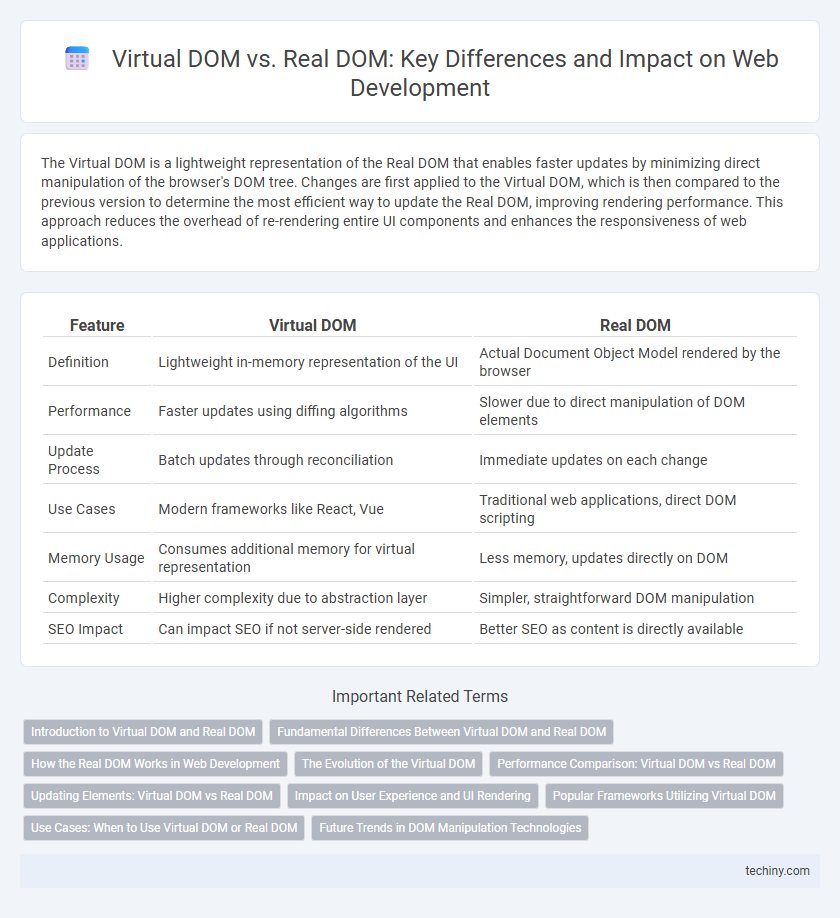The Virtual DOM is a lightweight representation of the Real DOM that enables faster updates by minimizing direct manipulation of the browser's DOM tree. Changes are first applied to the Virtual DOM, which is then compared to the previous version to determine the most efficient way to update the Real DOM, improving rendering performance. This approach reduces the overhead of re-rendering entire UI components and enhances the responsiveness of web applications.
Table of Comparison
| Feature | Virtual DOM | Real DOM |
|---|---|---|
| Definition | Lightweight in-memory representation of the UI | Actual Document Object Model rendered by the browser |
| Performance | Faster updates using diffing algorithms | Slower due to direct manipulation of DOM elements |
| Update Process | Batch updates through reconciliation | Immediate updates on each change |
| Use Cases | Modern frameworks like React, Vue | Traditional web applications, direct DOM scripting |
| Memory Usage | Consumes additional memory for virtual representation | Less memory, updates directly on DOM |
| Complexity | Higher complexity due to abstraction layer | Simpler, straightforward DOM manipulation |
| SEO Impact | Can impact SEO if not server-side rendered | Better SEO as content is directly available |
Introduction to Virtual DOM and Real DOM
The Real DOM represents the actual structure of a webpage as a tree of objects, directly reflecting the HTML elements rendered by the browser, while the Virtual DOM is a lightweight, in-memory representation of the Real DOM used by frameworks like React to optimize UI updates. Changes are first applied to the Virtual DOM, which performs a diffing algorithm to identify and batch minimal necessary updates before synchronizing them with the Real DOM, thereby improving performance and user experience. Understanding the distinction between Virtual DOM and Real DOM is crucial for efficient front-end development and optimized rendering workflows.
Fundamental Differences Between Virtual DOM and Real DOM
The Virtual DOM is a lightweight, in-memory representation of the Real DOM that allows for efficient updates by minimizing direct manipulation of the actual DOM. Real DOM updates are slow and costly because each change triggers a re-render of the entire UI, whereas the Virtual DOM batches changes and applies only the necessary updates. This fundamental difference enhances web application performance and responsiveness by reducing unnecessary browser repaint and reflow operations.
How the Real DOM Works in Web Development
The Real DOM in web development represents the actual structure of a web page as a tree of HTML elements, where each modification triggers a complete re-rendering of affected nodes, impacting performance. When a change occurs, the browser parses the updated HTML and rebuilds the entire DOM subtree, causing layout recalculations and potential repainting. This process often results in slower updates and reduced efficiency compared to the Virtual DOM, especially in complex or dynamic web applications.
The Evolution of the Virtual DOM
The evolution of the Virtual DOM has revolutionized web development by significantly improving rendering efficiency and user interface responsiveness. Unlike the Real DOM, which updates the entire UI tree on every change, the Virtual DOM creates a lightweight copy of the UI, enabling selective and optimized updates through efficient diffing algorithms. Modern frameworks like React and Vue leverage this technology to enhance performance, reduce memory consumption, and streamline developer workflows in complex web applications.
Performance Comparison: Virtual DOM vs Real DOM
Virtual DOM significantly improves performance by minimizing direct manipulation of the Real DOM, which is inherently slower due to its complex rendering process. It batches updates and applies them efficiently through a diffing algorithm, reducing unnecessary reflows and repaints in the browser. Real DOM updates trigger immediate rendering changes, causing higher computational costs and slower user interface responsiveness.
Updating Elements: Virtual DOM vs Real DOM
Updating elements in the Virtual DOM occurs through a diffing algorithm that efficiently compares the new and previous states, applying only necessary changes to the Real DOM, which minimizes performance costs. In contrast, direct updates to the Real DOM trigger immediate reflows and repaints, leading to slower rendering and reduced responsiveness. This optimized update mechanism of the Virtual DOM significantly enhances performance in dynamic web applications by reducing the frequency and complexity of DOM manipulations.
Impact on User Experience and UI Rendering
Virtual DOM improves user experience by enabling faster UI rendering through efficient diffing algorithms that update only changed elements, minimizing reflows and repaints. Real DOM manipulations are slower as they require full page re-rendering, often causing noticeable lag and jank during updates. By reducing direct DOM manipulation, Virtual DOM enhances responsiveness and smooth interactions in dynamic web applications.
Popular Frameworks Utilizing Virtual DOM
React, Vue.js, and Angular are some of the most popular frameworks utilizing the Virtual DOM to enhance web application performance. The Virtual DOM allows these frameworks to efficiently update and render UI components by minimizing direct manipulation of the Real DOM, which reduces rendering time and improves responsiveness. This approach significantly optimizes the user experience in dynamic single-page applications.
Use Cases: When to Use Virtual DOM or Real DOM
Virtual DOM is ideal for dynamic web applications with frequent UI updates, such as single-page applications (SPAs), where performance and responsiveness are critical. Real DOM suits static websites or simple pages with minimal interactivity, ensuring straightforward rendering and compatibility. Complex animations and interactions benefit from Virtual DOM's efficient diffing algorithm, while SEO-focused sites often rely on Real DOM for better crawlability.
Future Trends in DOM Manipulation Technologies
Future trends in DOM manipulation technologies emphasize enhanced performance and scalability through innovations like Incremental DOM and Fiber architecture, which optimize updates by minimizing re-renders. The rise of declarative frameworks such as React and Vue continues to shape how virtual DOM diffing algorithms evolve, improving synchronization with real DOM changes. Emerging standards like Web Components and native Shadow DOM usage suggest a move toward more modular, maintainable front-end architectures, reducing reliance on costly real DOM operations.
Virtual DOM vs Real DOM Infographic

 techiny.com
techiny.com